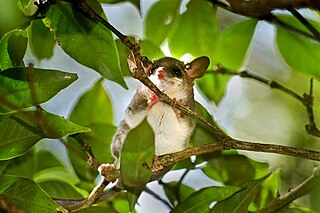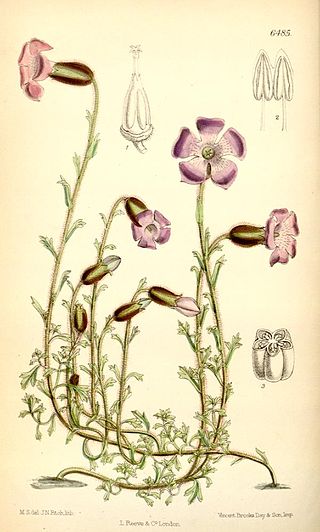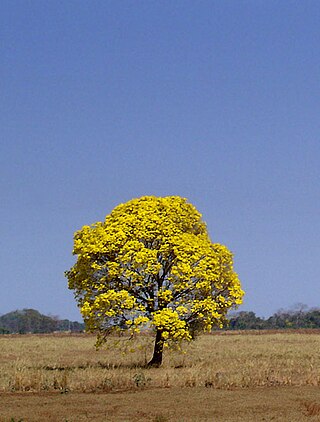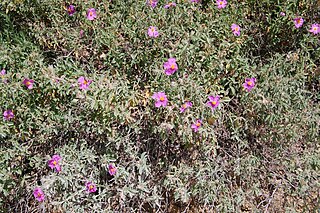
Ceanothus is a genus of about 50–60 species of nitrogen-fixing shrubs and small trees in the buckthorn family (Rhamnaceae). Common names for members of this genus are buckbrush, California lilac, soap bush, or just ceanothus. "Ceanothus" comes from Ancient Greek: κεάνωθος (keanōthos), which was applied by Theophrastus to an Old World plant believed to be Cirsium arvense.

Cistus creticus is a species of shrubby plant in the family Cistaceae. Though it usually has pink flowers, of 4.5–5 cm diameter, this species is very variable. It is widely known as a decorative plant. It is frequently called "Cistus incanus".

Coprosma is a genus of flowering plants in the family Rubiaceae. It is found in New Zealand, Hawaiian Islands, Borneo, Java, New Guinea, islands of the Pacific Ocean to Australia and the Juan Fernández Islands.

Cocculus is a genus of four species of woody vines and shrubs, native to tropical and subtropical regions of Africa and Asia.

The wandering tattler, is a medium-sized wading bird. It is similar in appearance to the closely related gray-tailed tattler, T. brevipes. The tattlers are unique among the species of Tringa for having unpatterned, greyish wings and backs, and a scaly breast pattern extending more or less onto the belly in breeding plumage, in which both also have a rather prominent supercilium.

The gray slender opossum, is an opossum species endemic to eastern Brazil.

The Brazilian slender opossum is an opossum species from South America. It is found in moist montane forest in the Atlantic Forest region of southeastern Brazil, including the states of Minas Gerais, Rio de Janeiro, São Paulo and Paraná. Its breeding may be fully semelparous, which is unusual for a mammal.

Marmosops is a genus of Neotropical opossums of the family Didelphidae. The genus was originally treated as a subgenus from the genus Marmosa rather than having their own classification. This was changed in 1989 by Gardner and Crieghton, who officially separated the group and made them their own genus. The mix-up between to genera Marmosa and Marmosops was common due to the similar appearances including size and other external features. However, the two groups differ significantly in their integument and in the arrangement of their skull and dentition. The dentition is similar in morphology between the two groups, with the exception of the deciduous lower third premolar varying from one genus to the next. The similarity between the two continues to cause the genus Marmosops to be frequently misidentified due to the lack of knowledge regarding the species along with the overlooked traits that help separate them from other opossums. The Marmosops are also commonly confused with the genus Gracilinanus, but this is quickly ruled out by a large number of differing characteristics. These differences include the arrangement of their digits, caudal scales, and the central hair on the scales changing from a three hairs per follicle to many more. This causes the hair of the Gracilinanus to be thicker and has also found to be heavily pigmented. The last group commonly confused with Marmosops is known as the genus Thylamys. These animals have a contrasting dorsal body pelage and the taxa are actually quite different.
The sombre catshark is a species of catshark in the family Scyliorhinidae. It is known from a single specimen south of Rote Island, northwestern Australia. Its natural habitat is the open seas.

Perityle is a genus of flowering plants in the daisy family. They are known generally as rock daisies.

Palmaria is an Italian island situated in the Ligurian Sea, at the westernmost end of the Gulf of La Spezia. With an area of 1.6 square kilometres (0.6 sq mi), it is the largest island of an archipelago of three closely spaced islands jutting from the mainland at Portovenere. The outer islands, Tino and the tiny Tinetto, lie further south.

Ceanothus incanus is a species of shrub in the family Rhamnaceae known by the common name coast whitethorn. It is endemic to California, where it is known from the San Francisco Bay Area through the North Coast Ranges into the Klamath Mountains.
Hosackia incana, synonym Lotus incanus, is a species of legume native to California. It is known by the common name woolly bird's-foot trefoil. It is endemic to the Sierra Nevada of California, where it grows in forests and other mountain habitat.

Malacothrix incana is an uncommon species of flowering plant in the family Asteraceae known by the common name dunedelion. This species is a mounding shrub with wooly leaves. It is endemic to California, where it grows only in sand dunes on the beaches of the Channel Islands and isolated spots along the mainland coastline in San Luis Obispo and Santa Barbara Counties. Malacothrix incana was first collected in San Diego, far south of its present range, but the plant is now extirpated from there.

Cyananthus is a genus of flowering plants that consists of about 30 species of annual or mostly perennial herbs from high mountains of Central and East Asia. They are little Himalayan plants no higher than 4 in. The name comes from the Greek word for blue flowers. Leaves are usually small and simple, sometimes narrowing to base, tooth-lobed at summit. In August to September, the plants bear showy of bright purplish-blue, yellow or white, funnel to bell-shaped, 5-lobed flowers 1 in in diameter with stamens free from the corolla and hairy throat. The flowers are borne singly on stalks. They always lose the aerial parts during the coldest months, and as spring begins, stems and leaves quickly start to reproduce.

Asimina incana, the woolly pawpaw, is a species of pawpaw. It is a shrub that grows to a height of 1.5 metres. Its leaves are 3–6 millimetres (0.12–0.24 in) long and leathery. It usually grows 1–4 flowers per node. Its pollen is shed as permanent tetrads.

Handroanthus is a genus of flowering plants in the family Bignoniaceae. It consists of 30 species of trees, known in Latin America by the common names poui, pau d'arco, or ipê. The latter sometimes appears as epay or simply ipe (unaccented) in English. The large timber species are sometimes called lapacho or guayacan, but these names are more properly applied to the species Handroanthus lapacho and Handroanthus guayacan, respectively.

The fauna of the State of California may be the most diverse in the United States of America. Of the Lower 48 conterminous states, California has the greatest diversity in climate, terrain and geology in general. The state's six life zones are the lower Sonoran (desert); upper Sonoran ; transition ; and the Canadian, Hudsonian, and Arctic zones, comprising California's highest elevations. California’s diverse geography gives rise to dozens of different ecosystems, each of which has its own unique native plants and animals. California is a huge state, the 3rd largest in the U.S., and can range broadly in habitat type.

Cistus × incanusL. is a hybrid between Cistus albidus and Cistus crispus. The name "Cistus incanus" has been used by other authors in a different sense, for Cistus creticus. The English name hoary rock-rose may refer to this species, among others.

Fanny Searls, also known by her married name Fanny Gradle, was an American physician and botanical collector. Dalea searlsiae, Searls' prairie clover, is named after her. Born in Waukegan, Illinois, she attended Northwestern University and the University of Michigan, gaining her medical degree in 1877. She then worked at Bellevue Hospital as a student nurse as there were few opportunities for women to gain medical internships at the time. In the meantime, she had developed skills as a concert pianist and a collector of botanical and geological specimens. In the last capacity, she donated a collection of 215 specimens gathered in Nevada to Northwestern University, including the first subsequently named Searls' prairie clover. She moved to Santa Barbara, dying there in 1939.

















